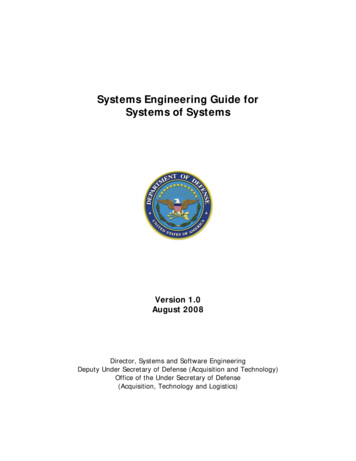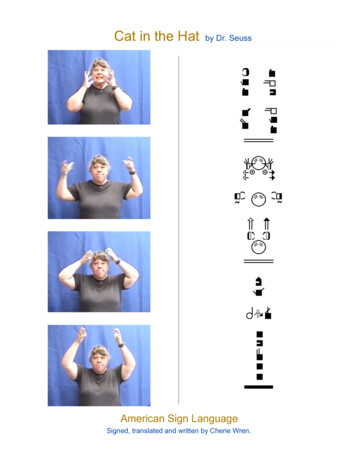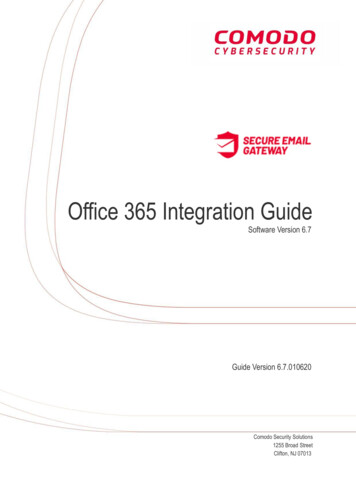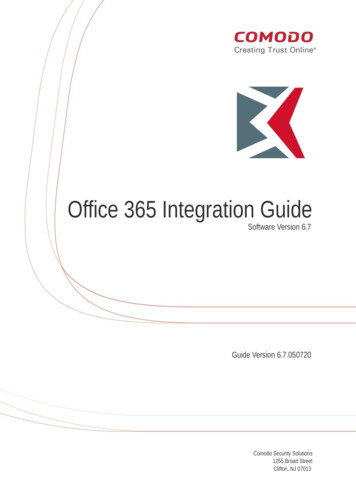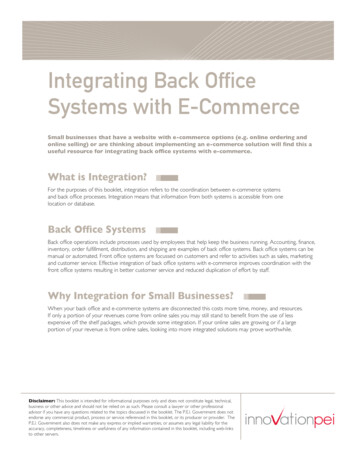
Transcription
Integrating Back OfficeSystems with E-CommerceSmall businesses that have a website with e-commerce options (e.g. online ordering andonline selling) or are thinking about implementing an e-commerce solution will find this auseful resource for integrating back office systems with e-commerce.What is Integration?For the purposes of this booklet, integration refers to the coordination between e-commerce systemsand back office processes. Integration means that information from both systems is accessible from onelocation or database.Back Office SystemsBack office operations include processes used by employees that help keep the business running. Accounting, finance,inventory, order fulfillment, distribution, and shipping are examples of back office systems. Back office systems can bemanual or automated. Front office systems are focussed on customers and refer to activities such as sales, marketingand customer service. Effective integration of back office systems with e-commerce improves coordination with thefront office systems resulting in better customer service and reduced duplication of effort by staff.Why Integration for Small Businesses?When your back office and e-commerce systems are disconnected this costs more time, money, and resources.If only a portion of your revenues come from online sales you may still stand to benefit from the use of lessexpensive off the shelf packages, which provide some integration. If your online sales are growing or if a largeportion of your revenue is from online sales, looking into more integrated solutions may prove worthwhile.Disclaimer: This booklet is intended for informational purposes only and does not constitute legal, technical,business or other advice and should not be relied on as such. Please consult a lawyer or other professionaladvisor if you have any questions related to the topics discussed in the booklet. The P.E.I. Government does notendorse any commercial product, process or service referenced in this booklet, or its producer or provider. TheP.E.I. Government also does not make any express or implied warranties, or assumes any legal liability for theaccuracy, completeness, timeliness or usefulness of any information contained in this booklet, including web-linksto other servers.
Examples of IntegrationA fully integrated online system Produces a packing slip for easy order fulfillment including items on backorder; Produces daily backorder lists and maintains inventory counts plus order lists for inventory that dropsbelow preset limits; Integrates with Canada Post and includes shipping costs on invoice (shipping costs based on weightand volume of products); Tells the customer if the item is out-of-stock and will be ordered plus approximate shipping time; Asks if the customer wants partial shipment of in-stock items or if they perfer to wait for all items beforemaking one shipment; Produces shipping labels for packaging; Automatically produces invoices marked paid at end of a transaction and emails it to the client; Integrates with accounting system and inputs the commissions or fees paid, shipping feesand all sales taxes; Handles all credit card transactions through the service provider’s accounts with a reasonable fee for thisservice;Benefits of Integration of Back Office and E-CommerceThe following diagram highlights the benefits of integrating back office systems with e-commerce. These benefitsinclude reduced duplication of effort and improved customer service.BenefitsReducedDuplicationIntegrationBack officeBack Office:Administration, HumanResources, Accounting,Finances, ShippingMiddle Office:OperationsFront Office:Sales, Marketing,Customer RelationsImprovedCustomer ServiceE-CommerceLevels of IntegrationKeep in mind that back office systems can be integrated at various levels as shown in the graphic below.Levels of Integration - Back Office Systems2No IntegrationSomeIntegration Back office databasesare not linked together Back office databasesare linked together E-commerce databasenot linked E-commerce databasenot linked/partially linkedCompleteIntegration Single back officeand online database
No integration means that employees will have extra work to do. For example, they would have to lookat two databases to check whether a customer has purchased a product or they may have to record salesinto two databases.Better integration means that information about online sales is automatically included in back office systems.This information does not have to be entered into the system more than once.Complete integration may be one-way or two-way, as illustrated by the following examples.Example #1: One-WayIntegrationExample #2: One-WayIntegrationExample #3: Two-WayIntegrationAs orders are placed in youronline store, the integrationsoftware automaticallydownloads the orders (allowingyou to see all of the orders).If your software allowsintegration with shippingprocesses, then you could alsoreceive a packing list andtransfer the shipping addressesand postal tracking numbersinto your accounting package.Your regular business (“bricksand mortar”) sales are enteredinto your accounting package.Once the shipping is completedyou have all the updated orderinformation in your accountingpackage. For customer inquires,you can use the informationcontained in the databaseto show you the updatedinformation (e.g. statusof the order).Any sales that occur in yourbricks-and mortar store(when entered into a softwarepackage) automaticallyupdates the stock numbersin your e-commerce package.This can help to reduceshipping wait times.Five Reasons to Integrate Your Back Office and E-Commerce Systems1. M ore Affordable Integration Options. Integration options for small businesses(e.g. off-the-shelf software) are now more affordable.2. Less Administrative Work. Administrative work is decreased because information is entered justonce. Integration also means you do not have to check information between systems.3. Lower Operational Costs. More efficient processes and less duplication of work can help reduceoverhead and cost of sales.4. Improved Customer Service. Customer service is improved because integration reduces delays inproviding information to the customer. For example, employees should be able to quickly check to see thestatus of a customer’s order. Integration gives you access to more accurate information about the product,pricing and stock availability. This information can be efficiently shared with the customer.5. Increased Readiness for Change. Devices such as cell phones and handheld computers arebecoming more popular ways to link to back office systems. Integration can help your business adapt tothis trend.Assessing Your Integration NeedsWhether you need to integrate your systems depends on how much of your business is done online. Review thefollowing table to help you assess if integration is right for you.Do you need to integrate your back office and e-commerce systems?1. Is a considerable portion of your business done online?2. Do employees have to check two or more databases to find out information about sales,inventory, shipping, etc.?3. Do employees have to enter information from the e-commerce site (e.g. numberof orders) into the back office database(s)? Do you have duplicate mailing lists betweendifferent types of customer lists?3YesNoIf you answered yes to the first question and yes to either questions 2 or 3, consider if you are ready tolink your back office and e-commerce systems.
What are Your Options?Your best integration option depends on what you already have in place. For example, if you have an onlinestorefront that you purchased from one service provider and back office software that came from anothersource, it will likely be difficult to link these systems. If your online store and back office software use open sourceprotocols (rules), then you could consider off-the-shelfsoftware packages. In choosing an appropriate optionIf you are thinking of setting up an onlineyou also need to consider:store, check to see if it will work with your The flexibility of the option - the option shouldbe as flexible as possible to allow your onlinebusiness to grow. Which e-commerce processes you want linked to yourback office (e.g. sales, available shopping cart items). The range of products you want to sell online.back office systems.If you are thinking of purchasing back officesoftware, check if it will work with youre-commerce system.Source: Integrating your back office and online systems.www.businesslink.gov.ukIntegration OptionsConsiderationsOff-the-ShelfSoftware Appropriate when you already have an existing e-commerce website.Software that is readilyavailable and requires littleor no customization. Thissoftware can help link yourexisting e-commerce andback-office systems. Most affordable, least complex solution. Appropriate when online business is growing, but a large portion of yourbusiness is offline. Will the software work with your back office systems? Will the software work with any other back office products or servicesyou use? (i.e. relational database management system, accountingpackages, delivery service). Do you need one-way or two-way integration? Do you need the two systemsto communicate with each other? For example, information about availabilityof products is imported to your online store and information about salesis imported to your accounting system.Off-the-ShelfE-CommerceSoftware withsome IntegrationCapabilities Appropriate when you are setting up an e-commerce website. Will the software work with your back office systems or products? What are the integration features? What e-commerce processes are linkedto the back office? Might be enough integration until your business reaches a certain size. Might require expert programming assistance.Leasing E-CommerceSolution through ASPLeasing an onlinestorefront throughan application serviceprovider (ASP). Someintegration is achievedthrough messaging with backoffice systems. This is a less complex solution because the integration is managed for you. Might not be enough integration if your online sales grow. Need to ensure that the ASP is credible and can provide the service. More expensive than off-the-shelf solutions.cont’d4
Integration OptionsConsiderationsCustomized More appropriate where online business is becoming critical to your business.Integration Software / Must work with major operating systems such as Windows or Linux.Middleware Is it written to open standards?Customized back office/5e-commerce softwareor middleware allowsthe two systems tocommunicate andwork together. Do you want the two systems to communicate in real time or through batchprocessing? Real time means that information between the two systems isinstantaneous. Batch processing means that the systems communicate atregular time intervals. Real-time is the more expensive option.Fully IntegratedE-Commerce System Suitable for businesses with complex e-commerce needs and for businesses thathave a large volume of online transactions.An e-commercesolution that allows forfull integration between thestorefront and back officeprocesses. Requires credible and experienced e-commerce service provider. Requires expert programming assistance. Very expensive.
AcknowledgementPermission to publish the information found in this booklet was received from theProvince of Ontario, Ministry of Economic Development and Innovation and theOntario Queen’s Printer. We are grateful for their support.This booklet is part of a series on advanced e-business topics whichsupplements an introductory handbook How You Can Profit fromE-Business. For more information on those publications, visit theInnovation PEI website at www.innovationpei.com/ebusiness.INNOVATION PEITelephone: (902) 368-6300Facsimile: (902) 368-6301E-mail: Business@gov.pe.caWebsite: www.innovationpei.com
Back office databases are linked together E-commerce database not linked/partially linked Single back office and online database No Integration . If your online store and back office software use open source protocols (rules), then you could consider off-the-shelf software packages. In choosing an appropriate option you also need .
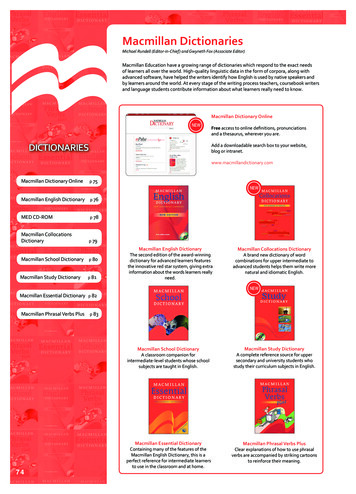

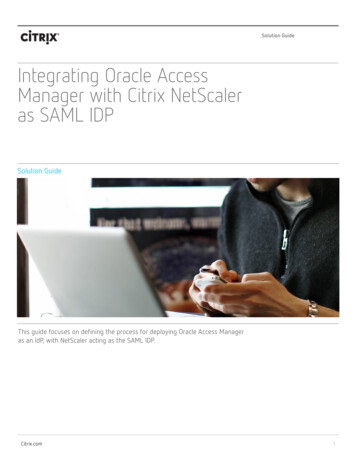

![Office 2010 Professional Plus Com Ativador Serial Keyl [EXCLUSIVE]](/img/61/office-2010-professional-plus-com-ativador-serial-keyl-exclusive.jpg)
